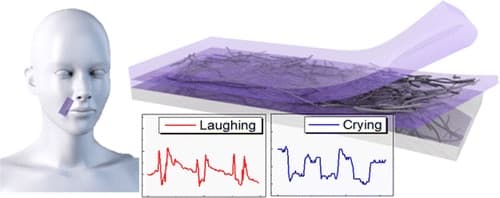Strain Sensors To Help Computers & Robots Read Human Expressions
New type of sensors developed by researchers will allow computers and robots to read your face and quickly figure out whether you are happy, upset, angry or depressed. Nae-Eung Lee and his team from Sungkyunkwan University at Seoul have developed highly sensitive, stretchable, transparent strain sensors for human-machine interface. These sensors can sit on human body and track even the small strains on the skin produced by various expressions like laughing or crying.
According to new research paper published in #-Link-Snipped-#, these new sensors will be deployed in multifunction human-machine interfaces comprising of carbon nanotubes and conductive elastomers. The researchers have used sensors made from environment friendly water-based solution processing so that they can be put on the skin. With stretchability of about 100%, gauge factor of about 62 and light transparency of about 62%, these sensors can be easily deployed on human face to detect even the smallest of the strains.

Image Credit: ACS Nano
The applications of this technology would be countless. Computer algorithms will be able to figure out your current emotional state and adjust its input and output accordingly. For example, if the computer determines that you are stressed, it can play your favorite music to help you relax. The UI/UX designers can accept input from these sensors and offer real-time modifications to the interface being presented to the user.
Researchers may also use the technology to monitor heart rate, breathing and other health related cues. Do let us know how can computer utilise the information offered by the strain sensors. We look forward to your comments.
According to new research paper published in #-Link-Snipped-#, these new sensors will be deployed in multifunction human-machine interfaces comprising of carbon nanotubes and conductive elastomers. The researchers have used sensors made from environment friendly water-based solution processing so that they can be put on the skin. With stretchability of about 100%, gauge factor of about 62 and light transparency of about 62%, these sensors can be easily deployed on human face to detect even the smallest of the strains.

Image Credit: ACS Nano
The applications of this technology would be countless. Computer algorithms will be able to figure out your current emotional state and adjust its input and output accordingly. For example, if the computer determines that you are stressed, it can play your favorite music to help you relax. The UI/UX designers can accept input from these sensors and offer real-time modifications to the interface being presented to the user.
Researchers may also use the technology to monitor heart rate, breathing and other health related cues. Do let us know how can computer utilise the information offered by the strain sensors. We look forward to your comments.
0
